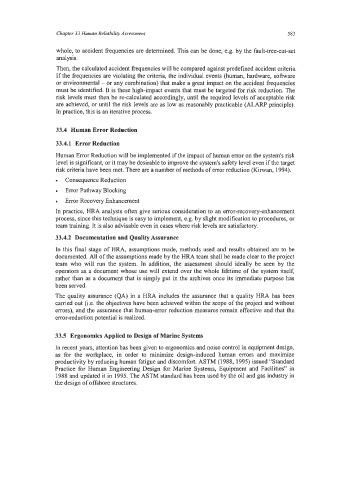Page 607 - Marine Structural Design
P. 607
Chapter 33 Human Reliability Assessment 583
whole, to accident frequencies are determined. This can be done, e.g. by the fault-tree-cut-set
analysis.
Then, the calculated accident frequencies will be compared against predefined accident criteria.
If the frequencies are violating the criteria, the individual events (human, hardware, software
or environmental - or any combination) that make a great impact on the accident fiequencies
must be identified. It is these high-impact events that must be targeted for risk reduction. The
risk levels must then be re-calculated accordingly, until the required levels of acceptable risk
are achieved, or until the risk levels are as low as reasonably practicable (ALARP principle).
In practice, this is an iterative process.
33.4 Human Error Reduction
33.4.1 Error Reduction
Human Error Reduction will be implemented if the impact of human error on the system’s risk
level is significant, or it may be desirable to improve the system’s safety level even if the target
risk criteria have been met. There are a number of methods of error reduction (Kirwan, 1994).
Consequence Reduction
Error Pathway Blocking
Error Recovery Enhancement
In practice, HRA analysts often give serious consideration to an error-recovery-enhancement
process, since this technique is easy to implement, e.g. by slight modification to procedures, or
team training. It is also advisable even in cases where risk levels are satisfactory.
33.4.2 Documentation and Quality Assurance
In this final stage of HRA, assumptions made, methods used and results obtained are to be
documented. All of the assumptions made by the HRA team shall be made clear to the project
team who will run the system. In addition, the assessment should ideally be seen by the
operators as a document whose use will extend over the whole lifetime of the system itself,
rather than as a document that is simply put in the archives once its immediate purpose has
been served.
The quality assurance (QA) in a HRA includes the assurance that a quality HRA has been
camed out (i.e. the objectives have been achieved within the scope of the project and without
errors), and the assurance that human-error reduction measures remain effective and that the
error-reduction potential is realized.
33.5 Ergonomics Applied to Design of Marine Systems
In recent years, attention has been given to ergonomics and noise control in equipment design,
as for the workplace, in order to minimize design-induced human errors and maximize
productivity by reducing human fatigue and discomfort. ASTM (1988, 1995) issued “Standard
Practice for Human Engineering Design for Marine Systems, Equipment and Facilities” in
1988 and updated it in 1995. The ASTM standard has been used by the oil and gas industry in
the design of offshore structures.

